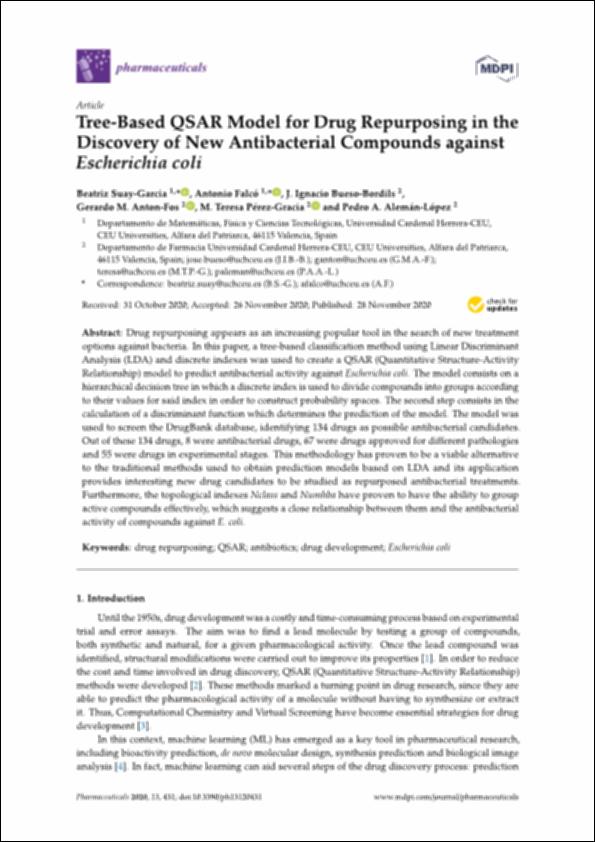Por favor, use este identificador para citar o enlazar este ítem:
http://hdl.handle.net/10637/12573Tree-based QSAR Model for drug repurposing in the discovery of new antibacterial compounds against "Escherichia coli"
| Título : | Tree-based QSAR Model for drug repurposing in the discovery of new antibacterial compounds against "Escherichia coli" |
| Autor : | Suay García, Beatriz Falcó Montesinos, Antonio Bueso Bordils, José Ignacio Antón Fos, Gerardo Manuel Pérez Gracia, María Teresa. Alemán López, Pedro |
| Materias: | Antibiotics - Mathematical models.; Drug resistance in microorganisms - Mathematical models.; Pharmaceutical microbiology - Mathematical models.; Farmacología molecular - Modelos matemáticos.; Biología molecular - Modelos matemáticos.; Antibióticos - Modelos matemáticos.; Escherichia coli - Resistencia a los medicamentos - Modelos matemáticos.; Escherichia coli - Drug resistance - Mathematical models.; Bacterias - Resistencia a los medicamentos - Modelos matemáticos.; Molecular pharmacology - Mathematical models.; Molecular biology - Mathematical models.; Microbiología farmacéutica - Modelos matemáticos. |
| Editorial : | MDPI |
| Citación : | Suay-Garcia, B., Falcó, A., Bueso-Bordils, J.I., Anton-Fos, G.M., Pérez-Gracia, M.T. & Alemán-López, P.A. (2020). Tree-based QSAR model for drug repurposing in the discovery of new antibacterial compounds against "Escherichia coli". Pharmaceuticals, vol. 13, i. 12 (28 nov.), art. 431. DOI: https://doi.org/10.3390/ph13120431 |
| Resumen : | Drug repurposing appears as an increasing popular tool in the search of new treatment options against bacteria. In this paper, a tree-based classification method using Linear Discriminant Analysis (LDA) and discrete indexes was used to create a QSAR (Quantitative Structure-Activity Relationship) model to predict antibacterial activity against Escherichia coli. The model consists on a hierarchical decision tree in which a discrete index is used to divide compounds into groups according to their values for said index in order to construct probability spaces. The second step consists in the calculation of a discriminant function which determines the prediction of the model. The model was used to screen the DrugBank database, identifying 134 drugs as possible antibacterial candidates. Out of these 134 drugs, 8 were antibacterial drugs, 67 were drugs approved for di erent pathologies and 55 were drugs in experimental stages. This methodology has proven to be a viable alternative to the traditional methods used to obtain prediction models based on LDA and its application provides interesting new drug candidates to be studied as repurposed antibacterial treatments. Furthermore, the topological indexes Nclass and Numhba have proven to have the ability to group active compounds e ectively, which suggests a close relationship between them and the antibacterial activity of compounds against E. coli. |
| Descripción : | Este artículo se encuentra disponible en la página web de la revista en la siguiente URL: https://www.mdpi.com/1424-8247/13/12/431 Este artículo pertenece a la colección "Old pharmaceuticals with new applications". |
| URI : | http://hdl.handle.net/10637/12573 |
| Derechos: | http://creativecommons.org/licenses/by/4.0/deed.es |
| ISSN : | 1424-8247 (Electrónico). |
| Fecha de publicación : | 8-may-2021 |
| Centro : | Universidad Cardenal Herrera-CEU |
| Aparece en las colecciones: | Dpto. Farmacia |
Los ítems de DSpace están protegidos por copyright, con todos los derechos reservados, a menos que se indique lo contrario.


